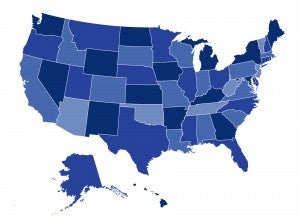
All but a handful of state departments of insurance participated in at least one of the four cycles of the Affordable Care Act (ACA) federal rate review grant program. The program awarded four cycles of grants, beginning in August of 2010, to help state insurance regulatory agencies build or enhance their rate review programs, or to develop state all-claims databases. As these grant funds run out and expiration dates for any extensions quickly approach, many regulators are planning for sustainability of the staffing levels they were able to achieve with the funds. While providing technical assistance to states struggling with these sustainability challenges, I was reminded of a similar challenge I faced during my first year as Indiana’s insurance commissioner. Some of the actions I took to meet that challenge may be helpful to regulators looking for approaches to sustaining their grant funded personnel.
A few months before being named commissioner in July of 1997, a Wall Street Journal reporter began researching a story about the Indiana Department of Insurance (IDOI). He chose the IDOI because the Department had not performed any market conduct examinations during the previous year, something he attributed to underfunding of the agency due to the cozy relationship between Indiana’s legislators and insurance companies. His research lasted about eight months and the story appeared in the paper’s January 14, 1998 edition.
After the article appeared, my staff and I determined that to address the identified problems the IDOI needed a dedicated Enforcement Unit with sole responsibility to investigate issues referred from the consumer services staff and other sources and to suggest disciplinary action when necessary. An additional consumer service representative also was needed. The Enforcement Unit was to be headed by a Chief Deputy of Enforcement, an attorney who also would oversee the Company Services (form review) and Consumer Services Divisions. Additional Enforcement Unit staff would include an attorney chief investigator, two additional investigators, and an administrative assistant. One more consumer service representative also was needed.
With no funding available in addition to what was already appropriated, we set out to meet our newly-identified needs by taking a close look at the vacancies on the agency’s staffing table. We identified vacant positions that were not absolutely necessary to fill and could be combined and/or reclassified. Some examples of how we accomplished this are:
- Several clerical positions were designated for work that could be distributed among two or three staff members without any one of them being overly burdened. Those vacancies were reclassified to combine two clerical positions into one investigator position for the new unit.
- The need for a vacant deputy position was eliminated by reclassifying a senior clerical staff position to make the person filling it a middle manager and placing the division formerly headed by the deputy in the vacant position under another deputy who could oversee the new manager.
- Because financial field examiners were required to be away from home during the week when conducting out-of-state exams for months at a time, they were very difficult positions to fill, but the salary was comparable to that of a staff attorney. We made the decision to reclassify the examiner positions to make them attorney positions and contract out the portion of our financial exams that would have been conducted by the individuals in those positions
Eventually, by poring through the staffing table and identifying these types of reclassification and savings opportunities, we were able to fully staff a new Enforcement Unit and add the additional consumer service representative while staying within the confines of the IDOI personnel budget.
Creating an Enforcement Unit by combining and reclassifying vacant positions was possible because we were given a great deal of leeway by the Governor. He also instructed the State Personnel Department to afford us the flexibility we needed. That kind of flexibility is not typical in most state bureaucracies, but given the urgency of the sustainability challenges states are currently facing, it might be worthwhile for them to seek more flexibility. With the necessary leeway to apply some of the techniques described above, where feasible, state insurance regulators may be better able to meet sustainability challenges presented by the expiration of federal rate review grants.

